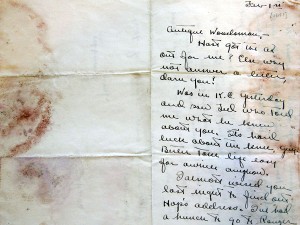
ANDOVER, Massachusetts — The paper conservator’s scalpel picked at the red and black specks, flicking away the fly droppings that had stained Ingrid Bergman’s letter to Ernest Hemingway.
“I shall remember people like you and forget the rest of the world,” the actress wrote to her author friend from Rome in 1950.
Six decades later, an effort to preserve that memory, and others that are part of the writer’s legacy, recently began inside a New England lab.
From mold, to mice, to moisture, the JFK Library and Museum in Boston is trying to save its collection of Hemingway’s incoming letters from different damage that has been degrading the batch as it ages. Box by box, thousands of letters to the author are heading to the Northeast Document Conservation Center in Andover for mending, washing, flattening and other repairs.
The center is a nonprofit that has also treated other parts of the Library’s Hemingway collection, as well as materials including Abraham Lincoln’s family Bible and documents George Washington wrote.
Walter Newman, the center’s paper conservation director, said the goal of the current Hemingway project is to slow down the different processes that are degrading the letters. Experts surveyed the damage about 18 months ago, and restoration work started on a recent afternoon when assistant conservator Claire Grund went to work on Bergman’s letter, among others.
“You can sort of pick them off,” Grund said, her scalpel targeting the insect excrement by the “Yours Ingrid” signoff in the letter Bergman addressed to “My dear Mister Papa.”
About half of the 7,500 letters in the incoming collection need restoration work. JFK Library’s Hemingway curator Susan Wrynn said most letters are worth around $5,000.
Wrynn estimates the preservation project will take two or three more years and cost at least $300,000. The JFK Foundation is working on raising funds to cover the price.
After Hemingway’s 1961 suicide, President John F. Kennedy made arrangements for the author’s fourth wife, Mary, to go to Cuba during a U.S. ban on travel there. Cuban leader Fidel Castro let her reclaim some of her husband’s documents and possessions in exchange for donating Hemingway’s villa outside Havana and other belongings to the Cuban people.
Mary Hemingway shipped crates of documents on a shrimp boat to Florida, also retrieving papers from other places her husband lived, before offering the collection to Jacqueline Kennedy for her husband’s presidential library.
The papers started arriving in Boston 40 years ago, when library officials stored them in a dark vault where they could control temperature and humidity levels. But that didn’t keep iron gall ink, a corrosive and once-common writing agent, from eating through the paper some of the letters came on.
It also couldn’t reverse mold growth or repair rodent nibbles on letters that spent years in storage in humid spots like Key West or Cuba. Letters penned on acidic paper also began falling apart as their fibers aged.
“His documents were kept in so many places over time. There are so many things that have happened to them,” Wrynn said. “The deterioration just continues, so if you don’t become proactive at some point, you have the potential to lose information.”
Among letters needing repair are some from the writer’s family, childhood cronies, and war and fishing buddies. Besides two of Bergman’s letters, correspondence from Hollywood stars Marlene Dietrich and Gary Cooper will undergo work, as well.
Also slated for restoration are letters from Max Perkins, Hemingway’s editor at Scribner’s, and correspondence from writers Gertrude Stein, Walter Winchell and Martha Gellhorn, the journalist who became the author’s third wife.
World War I-era dispatches from Agnes von Kurowsky, the Red Cross nurse upon whom Hemingway based his Catherine Barkley character in “A Farewell to Arms,” also need saving from extensive mold, water and corrosive ink damage.
Handling the letters that belonged to the Nobel- and Pulitzer Prize-winning writer while boxing them for transport to the lab is a task library officials undertake with a focus and reverence worthy of holy relics.
“Your heart does kind of stop,” Wrynn said in the midst of a recent boxing operation.
Among the next batch of letters that will head to the lab this fall will be four Western Union telegrams F. Scott Fitzgerald sent Hemingway from 1934 to 1937. In two of them, the writer talks about plans to visit his friend in Key West.
“Could make three day stay …. not up to anything strenuous probably result of teatotaling since January,” he messaged Hemingway from Baltimore in May 1935.
But Hemingway was busy — probably off chasing marlin.
A note on the telegram, believed to be handwritten by Hemingway’s second wife Pauline Pfeiffer, showed Fitzgerald’s suggestion was met with a return wire expressing regrets.
“Ernest in Bimini, forwarding your message, so sorry Love P,” it said.